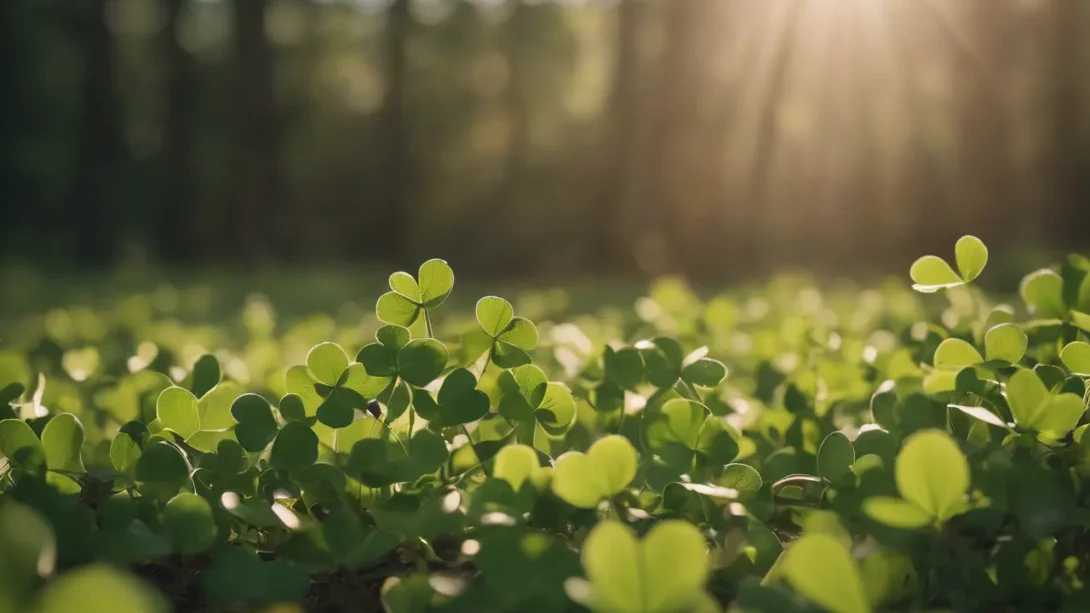Clover, a member of the legume family, is celebrated for its versatility and numerous benefits across gardens, lawns, and agricultural landscapes. Recognized for its ability to fix nitrogen in the soil, clover is a gardener’s ally for enhancing soil fertility and promoting a healthier, greener environment. This article aims to delve into the growth timeline of clover, highlighting the stages from seed germination to maturity and the factors that influence its development.
Clover
Types of Clover
Clover comes in various types, each with its unique characteristics and advantages. Common varieties include:
- White Clover (Trifolium repens): Known for its durability and low-growing habit, white clover is a favorite for lawns and ground cover, offering a continuous bloom of white flowers.
- Red Clover (Trifolium pratense): Taller than its white counterpart, red clover is often used in agricultural settings for forage and as a green manure crop.
- Crimson Clover (Trifolium incarnatum): With its vibrant crimson flowers, this clover is not only visually appealing but also an excellent cover crop for improving soil health.
Benefits of Planting Clover
Clover serves multiple roles in an eco-friendly garden or farm:
- Nitrogen Fixation: As a legume, clover has the unique ability to convert atmospheric nitrogen into a form that plants can use, naturally enriching the soil.
- Attracting Beneficial Insects: The flowers of clover are a magnet for pollinators and beneficial insects, promoting biodiversity.
- Soil Protection: Clover’s dense growth can prevent soil erosion, suppress weeds, and improve soil structure.
Growth Timeline of Clover
Germination Phase
Clover seeds typically begin to germinate within 7 to 14 days under optimal conditions. This phase requires moist soil and mild temperatures, with germination rates potentially slowing in colder or excessively wet conditions.
Vegetative Growth
After germination, clover enters a vegetative growth phase, where it develops its root system and foliage. This stage is crucial for establishing a strong plant that can withstand environmental stresses and begin spreading. Most clover varieties reach maturity and start to spread within 4 to 6 weeks after germination, with variations depending on the specific type of clover and growing conditions.
Flowering and Seeding
Clover plants generally start flowering several weeks after reaching full vegetative growth, often between 6 to 8 weeks from germination. The flowering period can last several weeks, during which the plant produces seeds that can contribute to natural reseeding. The exact timing of flowering and seed production varies among clover species and is influenced by environmental factors.
Factors Influencing Clover Growth
The journey from seed to a flourishing clover plant is influenced by a combination of environmental conditions and management practices. Understanding these factors can help optimize clover growth and maximize its benefits.
Soil Conditions
Clover thrives in well-draining soil with a neutral to slightly acidic pH. Soil fertility can impact growth, with moderately fertile soils typically providing the best results. While clover is known for its nitrogen-fixing capabilities, the presence of other nutrients, such as phosphorus and potassium, supports healthy development. Testing soil and adjusting its composition with organic matter or specific amendments can create an ideal growing environment.
Climate and Weather
Temperature and moisture are critical for clover germination and growth. Clover seeds germinate best in soil temperatures between 59°F to 68°F (15°C to 20°C). However, different varieties may have specific temperature preferences. Adequate rainfall or irrigation during the early stages of growth ensures successful establishment, while extreme conditions like drought or excessive rainfall can hinder development.
Management Practices
The success of clover, whether in a lawn or as a cover crop, can be significantly influenced by how it’s planted and maintained:
- Planting Depth: Clover seeds should be sown at a shallow depth, no more than ¼ inch deep, to ensure proper germination.
- Watering: Consistent moisture is crucial during the germination phase, followed by regular watering to support growth until the plants are well-established.
- Mowing: In lawn settings, mowing clover to a height of about 3 inches encourages bushier growth and maintains a manicured appearance without harming the plant’s ability to flower and reseed.
Planting and Care Guide for Clover
To successfully integrate clover into your green space, a few key steps and ongoing care practices should be followed.
Best Time to Plant
The ideal time to plant clover is in the spring or late summer/early fall. These planting windows allow the clover to establish itself under favorable weather conditions, avoiding the extreme heat of summer or the cold of winter.
Preparing the Planting Site
Good soil preparation is essential for clover:
- Clear the area of existing weeds and grass to reduce competition.
- Loosen the soil to improve drainage and aeration, especially if the soil is compacted.
- Amend the soil based on a soil test to adjust pH and nutrient levels as needed.
- Sow the seeds evenly, considering mixing with sand for better distribution, and lightly rake them into the topsoil.
Ongoing Care and Maintenance
Once planted, clover requires minimal care but benefits from a few maintenance practices:
- Watering: Keep the soil consistently moist until seeds have germinated and plants are established. Afterward, clover is relatively drought-tolerant but may benefit from occasional watering during prolonged dry spells.
- Weeding: Although clover can outcompete many weeds, removing any large or invasive weeds early on can help young plants establish.
- Fertilization: Generally, clover does not require additional fertilization due to its nitrogen-fixing ability. However, a light application of a balanced, organic fertilizer can support growth in very poor soils.
Common Challenges in Growing Clover
While clover is relatively easy to grow and maintain, like any plant, it can face challenges that may impact its growth and health. Being aware of these potential issues and knowing how to address them can ensure a thriving clover patch.
Pests and Diseases
Clover is generally resistant to many pests and diseases, but it’s not immune. Common issues include:
- Root rot can occur in overly wet conditions, emphasizing the need for well-draining soil.
- Powdery mildew may affect the leaves in humid conditions, which can be mitigated by ensuring good air circulation around the plants.
- Aphids and weevils can sometimes be attracted to clover; natural predators or organic insecticides can help manage these pests.
Regular monitoring and early intervention can prevent these issues from becoming severe, allowing your clover to thrive.
Competition with Other Plants
Clover can be both competitive and cooperative in a garden setting, but it may struggle if overshadowed by taller plants or aggressive weeds. Maintaining a balance involves:
- Regular weeding to prevent competition for nutrients and light.
- Strategic planting or mowing to ensure clover isn’t overwhelmed by surrounding vegetation.
Maximizing Clover Benefits
Incorporating clover into your lawn, garden, or as a cover crop in agricultural settings can provide numerous benefits. To make the most of clover’s potential, consider the following strategies:
Integrating Clover into Lawns and Gardens
Clover can be a valuable addition to lawns and garden beds, offering a lush, green appearance, attracting beneficial insects, and improving soil health. To integrate clover effectively:
- Mix clover seeds with grass seeds for a diverse, self-fertilizing lawn.
- Plant clover as a ground cover in garden beds to suppress weeds and retain soil moisture.
Using Clover as a Cover Crop
In agricultural or large garden settings, clover serves as an excellent cover crop:
- Plant clover in fallow fields to prevent erosion and improve soil structure.
- Use clover to fix nitrogen in the soil, reducing the need for chemical fertilizers in subsequent crops.
Clover’s ability to enrich the soil and support a healthy ecosystem makes it a valuable plant in sustainable agriculture practices.
Conclusion
From its rapid germination to its beneficial impact on soil and ecosystems, clover is a versatile and valuable plant. Whether you’re looking to enhance your lawn, garden, or agricultural land, understanding the growth process, care requirements, and potential challenges of clover can help you achieve the best results. By following the guidelines outlined in this article, you can enjoy the lush beauty and ecological benefits of clover for years to come. Embrace the simplicity and sustainability of clover, and let it transform your green spaces into vibrant, healthy environments.



